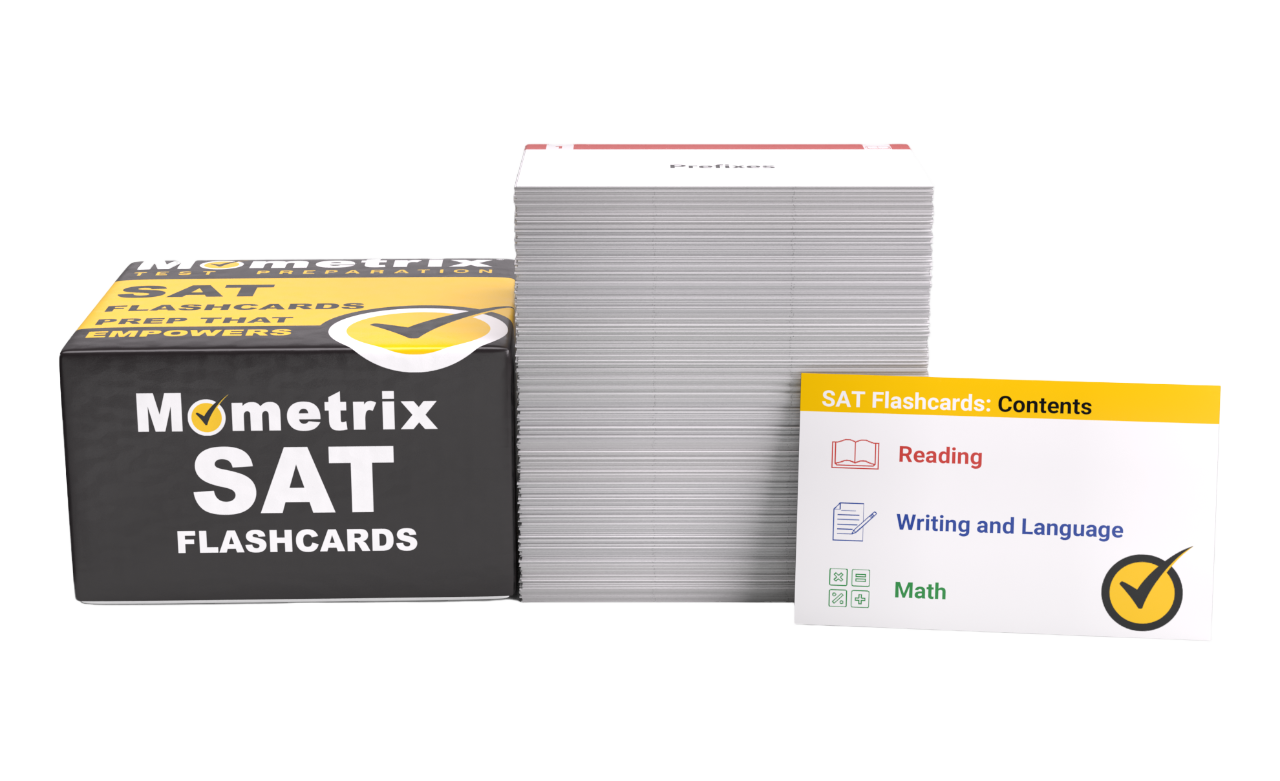Almost everyone who has started high school has heard of the SAT. Whether you need help studying for the SAT or just want some more information about what the test is like, you’ve come to the right place!
This page will cover everything you need to know about the SAT, such as what information the examination covers, the number and type of questions you can expect, and what score you need to pass.
What is the SAT?
The SAT exam is a standardized test used for college admissions in the United States. The exam was introduced in 1926 under the name Scholastic Aptitude Test but has since become known simply as the SAT. The test was created to assess high-school students’ readiness for college and to provide colleges with a standard benchmark to evaluate applicants.
Today, more than 4,000 colleges and universities in the US and 85 other countries use SAT scores to make admission decisions!
Test Outline
The SAT contains 98 questions, and you will have 134 minutes to complete it. The majority of SAT questions will be multiple-choice, but there are some questions in the Math section that require you to type your answer instead of choosing from a list of choices.
The test is divided into two sections:
1. Reading and Writing (54 questions)
In the Reading and Writing section, you will be given 64 minutes to read a selection of passages and respond to questions regarding their content. This section is split into two modules, each containing 27 questions (54 questions total).
The questions cover four distinct topics:
These questions focus on how well you can comprehend and analyze a passage of text, as well as your ability to interpret and evaluate information and ideas from text and informational graphics.
Craft and Structure
These questions deal with vocabulary, analysis, and general reasoning skills, ensuring that you understand and can use high-utility words in context and make connections between related texts.
Expression of Ideas
These questions concentrate on your ability to revise text to make it more effective and meet specific rhetoric goals.
Standard English Conventions
These questions are based entirely on grammar rules. As such, this skill category will assess your understanding of such concepts as how to properly utilize commas, compose sentences, and similar concepts.
2. Math (44 questions)
In the Math section, you will be given 70 minutes to answer all 44 questions. This section is also split into two modules, each containing 22 questions, and you will be able to use a calculator on all portions of this section.
The questions in this section are split into four broad categories:
These questions focus on your ability to analyze and solve linear equations, inequalities, and systems of equations through various methods.
There are five main types of algebra questions on the SAT:
- Linear equations in one variable
- Linear equations in two variables
- Linear functions
- Systems of two linear equations in two variables
- Linear inequalities in one or two variables
Advanced Math
These questions assess your skills and knowledge related to more advanced concepts you might find in advanced math courses.
There are four main types of advanced math questions on the SAT:
- Equivalent expressions
- Nonlinear equations in one variable
- Systems of equations in two variables
- Nonlinear functions
Problem-Solving and Data Analysis
These questions evaluate your quantitative reasoning skills, as well as your ability to grasp unit rates and analyze data involving one or more variables.
There are seven main types of problem-solving and data analysis questions on the SAT:
- Ratios, rates, proportional relationships, and units
- Percentages
- Distributions and measures of center and spread
- Models and scatterplots
- Probability and conditional probability
- Inference from sample statistics and margin of error
- Evaluating statistical claims: observational studies and experiments
Geometry and Trigonometry
These questions measure your ability to solve general geometry and trigonometry problems.
There are four main types of geometry and trigonometry questions on the SAT:
- Area and volume formulas
- Lines, angles, and triangles
- Right triangles and trigonometry
- Circles
Check Out Mometrix's SAT Study Guide
Get practice questions, video tutorials, and detailed study lessons
Get Your Study Guide
Registration
Registration for the SAT can be done on the College Board website. You may take the SAT at any time during your final two years of high school on dates set by the College Board.
Many students take the exam in the spring of their junior year. This will give you enough time to take the exam twice, which is strongly advised because most students perform better on the second attempt.
You’ll be able to identify your areas of weakness and get ready to retake the test if you so choose once you receive your initial test results in your junior year. If you weren’t happy with your initial score, you can retake the test in the fall of your senior year.
The registration cost for the SAT exam is $68, though a fee waiver is available to some students.
SAT Testing
Before the Test
Exam centers open at 7:45 am, and doors close at 8:00 am. Check your admission ticket to confirm your arrival time and the location of your testing facility.
To verify your registration and identity, test center staff will cross-reference the information on your Admission Ticket and your photo ID with the roster. If any of the information doesn’t match, you will not be allowed into the testing room.
Your ID must be a valid photo ID that is government-issued or issued by the school you currently attend. It must have a recent recognizable photo that clearly matches your appearance on the test day and the photo you provided when you registered.
You should also be ready to answer questions about your health when arriving at the test center. If you are feeling unwell on the day of your exam, you are advised to stay at home; there will be no charge or cancellation fee if you miss the test because you are unwell. It is your responsibility to be aware of and adhere to any quarantine regulations or travel restrictions in the area where you are testing if you are traveling there to take the test.
During the Test
Between 8:30 and 9:00, the proctor will begin the test, noting when it’s time to move on to the next section. It is important to note that once a section has ended, you cannot go back to it. If you finish early, you cannot move on to the next section early.
You can ask the proctor questions, but they can only respond to questions about the process, not the test questions or content. They will read all instructions verbatim from the SAT manual prior to the start of the exam.
Typically, there are two breaks during the test: one 10-minute break and one 5-minute break. These are the only times you can eat or drink during the test.
Calculators, test books, and answer sheets must all stay on your desk during breaks. Accessing and powering up your mobile phones or other devices is strictly prohibited, and your scores may be canceled if you disregard this rule.
After the Test
Before you are allowed to leave the testing room, the proctor will gather and count the test books at the end of the test to ensure that all required materials have been turned in.
Don’t be surprised if your test experience isn’t exactly like that of the student sitting next to you. The sections in your test book may be different.
About the Digital SAT
In 2023, the SAT transitioned to be fully digital to meet the changing needs of students and educators.
Bluebook is the custom-built digital testing app that is being used by SAT to administer the exam. Before the test, Bluebook needs to be downloaded to your device, and you will need to do a quick exam setup one to five days before your test. The software will verify that your device satisfies all specifications before downloading your exam and producing your admission ticket.
After you have been seated and your device is connected to the center’s Wi-Fi, the Bluebook application will guide you through the instructions. The proctor may only be questioned regarding procedure; test questions or content cannot be discussed.
You will be given a start code by the proctor. Once the start code has been entered, your test will start, and Bluebook will track the time of your test.
As you take the test, your responses are saved on your device, and your answers are submitted automatically once the test is complete.
Testing Devices
You can take the Digital SAT on a wide range of devices, including your own laptop, iPad, Windows tablet, or school-owned Chromebook.
Your device must be able to connect to Wi-Fi and have a sufficient battery life of three hours or more. Students are permitted to use a mouse and an external keyboard, but all programs and applications must be closed during the test.
Check Out Mometrix's SAT Flashcards
Get complex subjects broken down into easily understandable concepts
Get Your Flashcards
Score Ranges
Every student stresses about their SAT because it holds a lot of weight on their academic future. Knowing what a good SAT score is can make a difference in your prep time, as you can have a goal to reach.
Scores for the SAT range between 400 and 1600, and the SAT average score is 1050. Any score higher than that would be considered above average and acceptable by many colleges. You would be in the top 10% of test takers with a score of 1350, which would help your application stand out to more selective colleges!
Click below to find more information about how certain SAT scores predict you making a higher salary later in life, as well as which colleges have the best track record for translating high SAT scores into higher salaries.
When Do Scores Come Out?
Release dates differ for the SAT depending on whether you took the exam on a weekend or school day. For those who took the test on a Saturday, they can expect their scores about 2 weeks later, while those who took it on a school day can expect to get theirs 3-4 weeks later.
The time that your SAT score comes out differs for everyone because they stagger releasing scores to help with the very large number of students accessing their results. All scores will be released by 8 pm ET on your set release date. Scores might take a little longer for SAT administrations in the summer.
SAT vs. ACT vs. PSAT
The SAT, ACT, and PSAT are each used to help you get into college, but there are some notable differences among them. Wondering which test is right for you?
Take a look at the details of each exam here:
| Time | ||
|---|---|---|
| SAT | ACT | PSAT |
| 2 hours and 45 minutes (+50 minutes for Essay section) | 3 hours (estimated) | 2 hours and 45 minutes |
| Question Count | ||
|---|---|---|
| SAT | ACT | PSAT |
| 98 (mostly multiple-choice questions) | 171 (multiple-choice questions) | 139 questions (estimated) |
| Section Count | ||
|---|---|---|
| SAT | ACT | PSAT |
| 2 sections | 3 sections (+2 optional sections) | 3 sections |
| Subjects | ||
|---|---|---|
| SAT | ACT | PSAT |
|
|
|
| Test Dates | ||
|---|---|---|
| SAT | ACT | PSAT |
| Dates set by the College Board |
| Annually in October |
| Registration Methods | ||
|---|---|---|
| SAT | ACT | PSAT |
| Online | Online and by mail | Registration handled by the school |
| Fee | ||
|---|---|---|
| SAT | ACT | PSAT |
| $68 | $65: without writing section $90: with writing section | $18 (varies based on school or state funding) |
| Fee Waiver | ||
|---|---|---|
| SAT | ACT | PSAT |
| Subject to region | Yes | Yes (for eligible low-income students) |
| Receive Scores | ||
|---|---|---|
| SAT | ACT | PSAT |
| 2-4 weeks | 3-8 weeks | 50 days (estimated) |
| Pass or Fail | ||
|---|---|---|
| SAT | ACT | PSAT |
| No | No | Yes |
| Time | ||
|---|---|---|
| SAT | ACT | PSAT |
| 2 hours and 45 minutes (+50 minutes for Essay section) | 3 hours (estimated) | 2 hours and 45 minutes |
| Question Count | ||
|---|---|---|
| SAT | ACT | PSAT |
| 98 (mostly multiple-choice questions) | 215 (multiple-choice questions) | 139 questions (estimated) |
| Section Count | ||
|---|---|---|
| SAT | ACT | PSAT |
| 2 sections | 4 sections (+1 optional section) | 3 sections |
| Subjects | ||
|---|---|---|
| SAT | ACT | PSAT |
|
|
|
| Test Dates | ||
|---|---|---|
| SAT | ACT | PSAT |
| Dates set by the College Board |
| Annually in October |
| Registration Methods | ||
|---|---|---|
| SAT | ACT | PSAT |
| Online | Online and by mail | Registration handled by the school |
| Fee | ||
|---|---|---|
| SAT | ACT | PSAT |
| $60 | $69: without writing section $94: with writing section | $18 (varies based on school or state funding) |
| Fee Waiver | ||
|---|---|---|
| SAT | ACT | PSAT |
| Subject to region | Yes | Yes (for eligible low-income students) |
| Receive Scores | ||
|---|---|---|
| SAT | ACT | PSAT |
| 2-4 weeks | 3-8 weeks | 50 days (estimated) |
| Pass or Fail | ||
|---|---|---|
| SAT | ACT | PSAT |
| No | No | Yes |

SAT Online Prep Course
If you want to be fully prepared, Mometrix offers an online SAT prep course designed to give you everything you need to succeed!
Here’s what you’ll find in the SAT course:
Everyone learns differently, so we’ve tailored the SAT online prep course to ensure every learner has what they need to prepare for the SAT exam.
Click below to check it out!
FAQs
Q
What is a good SAT score?
A
Any score that is above 1050 is considered above average, which means that most colleges would accept it. To be more competitive as you apply to different schools, a score of at least 1350 is suggested.
Q
How long is the SAT?
A
The SAT is timed at 134 minutes in total.
Q
What does SAT stand for?
A
Originally, SAT stood for “Scholastic Aptitude Test,” but the acronym no longer has any specific meaning.
Q
What is the average SAT score?
A
The average SAT score is 1050.
Q
When do you take the SAT?
A
It is recommended that you take the SAT in the spring of your junior year of high school. If you are unhappy with your score after that, you can retake it in the fall of your senior year.
Q
What time do SAT scores come out?
A
All scores will be released by 8 p.m. ET on your set release date. However, scores might take a little longer for the SAT administrations in the summer.
Q
What is a perfect SAT score?
A
A SAT perfect score is 1600, and the minimum score you can get is 400.
Q
How many questions are on the SAT?
A
There are a total of 98 questions on the SAT, most of which are multiple choice.
Q
How many times can you take the SAT?
A
You may take the SAT as many times as you want. In fact, most students achieve a higher score on the test the second time they take it, so it is encouraged that you retake the exam if your score did not meet your expectations.


